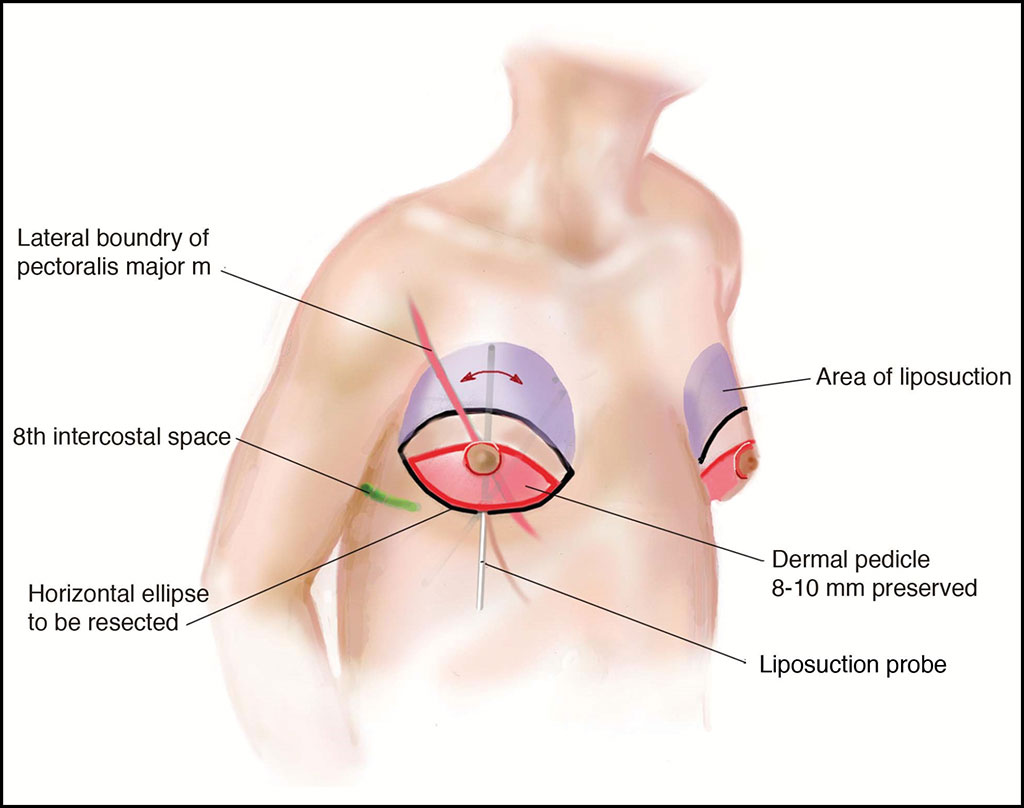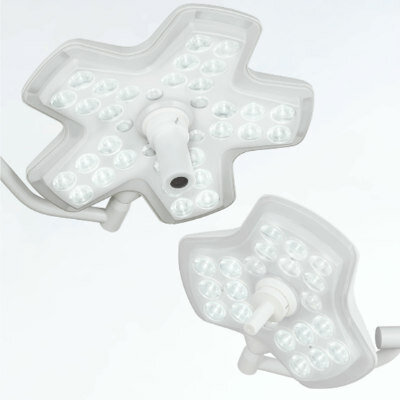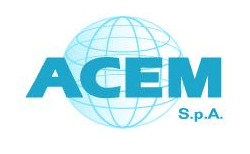New Surgical Technique Helps Treat Pseudogynecomastia
|
By HospiMedica International staff writers Posted on 02 Jul 2020 |

Image: Illustration of preoperative markings and pertinent reference points (Courtesy of UT Soutwestern)
A novel excisional approach helps male patients with pseudogynecomastia following massive weight loss (MWL), according to a new study.
Developed by researchers at the University of Texas (UT) Southwestern Medical Centre (Dallas, TX, USA) and in private practice, the technique involves a modified elliptical excision and nipple-areola complex (NAC) transposition on a thinned inferior dermal pedicle, in addition to liposuction, as an alternative to conventional mastopexy body contouring procedures for treating male chest deformity after MWL, which often leads to suboptimal results. The researchers reported the results of a retrospective chart review in 14 male patients, who were followed for an average of 8.1 months.
The patients were characterized by age, method of weight loss, pre-weight loss body mass index (BMI), post-weight loss BMI, total weight loss, grade of pseudogynecomastia, and concurrent procedures. The average weight lost was 79.72 kg, with pre-weight loss BMI averaging 52.0 kg/m2 and post-weight loss BMI 29.6 kg/m2. The average amount of tissue removed was 2,615 grams. In all, 28.6% of the patients experienced minor complications, including asymmetry, delayed wound healing, hyperpigmentation, and seroma. There were no wound infections, hematomas, flap necrosis, or dysesthesia. The study was published on June 16, 2020, in Aesthetic Surgery Journal: Open Forum.
“Due to several cosmetic advantages and low complication profile, our technique is an attractive option for treating male chest deformity after MWL,” concluded senior author Professor Jeffrey Kenkel, MD, of UT Southwestern Medical Center, and colleagues. “This is a nice alternative to the standard nipple grafting techniques we have used for years. It allows us to preserve the shape of the nipple and in many cases the color in patients of color.”
Pseudogynecomastia is defined by retained retroareolar fat without glandular hypertrophy, often with excess tissue and skin anteriorly and laterally; this in contrast to gynecomastia, which is often idiopathic and results in proliferation of glandular tissue. Treatment for pseudogynecomastia generally requires excision of excess tissue and skin for all but the mildest forms.
Related Links:
University of Texas Southwestern Medical Centre
Developed by researchers at the University of Texas (UT) Southwestern Medical Centre (Dallas, TX, USA) and in private practice, the technique involves a modified elliptical excision and nipple-areola complex (NAC) transposition on a thinned inferior dermal pedicle, in addition to liposuction, as an alternative to conventional mastopexy body contouring procedures for treating male chest deformity after MWL, which often leads to suboptimal results. The researchers reported the results of a retrospective chart review in 14 male patients, who were followed for an average of 8.1 months.
The patients were characterized by age, method of weight loss, pre-weight loss body mass index (BMI), post-weight loss BMI, total weight loss, grade of pseudogynecomastia, and concurrent procedures. The average weight lost was 79.72 kg, with pre-weight loss BMI averaging 52.0 kg/m2 and post-weight loss BMI 29.6 kg/m2. The average amount of tissue removed was 2,615 grams. In all, 28.6% of the patients experienced minor complications, including asymmetry, delayed wound healing, hyperpigmentation, and seroma. There were no wound infections, hematomas, flap necrosis, or dysesthesia. The study was published on June 16, 2020, in Aesthetic Surgery Journal: Open Forum.
“Due to several cosmetic advantages and low complication profile, our technique is an attractive option for treating male chest deformity after MWL,” concluded senior author Professor Jeffrey Kenkel, MD, of UT Southwestern Medical Center, and colleagues. “This is a nice alternative to the standard nipple grafting techniques we have used for years. It allows us to preserve the shape of the nipple and in many cases the color in patients of color.”
Pseudogynecomastia is defined by retained retroareolar fat without glandular hypertrophy, often with excess tissue and skin anteriorly and laterally; this in contrast to gynecomastia, which is often idiopathic and results in proliferation of glandular tissue. Treatment for pseudogynecomastia generally requires excision of excess tissue and skin for all but the mildest forms.
Related Links:
University of Texas Southwestern Medical Centre
Latest Surgical Techniques News
- Minimally Invasive Endoscopic Surgery Improves Severe Stroke Outcomes
- Novel Glue Prevents Complications After Breast Cancer Surgery
- Breakthrough Brain Implant Enables Safer and More Precise Drug Delivery
- Bioadhesive Sponge Stops Uncontrolled Internal Bleeding During Surgery
- Revolutionary Nano Bone Material to Accelerate Surgery and Healing
- Superior Orthopedic Implants Combat Infections and Quicken Healing After Surgery
- Laser-Based Technique Eliminates Pancreatic Tumors While Protecting Healthy Tissue
- Surgical Treatment of Severe Carotid Artery Stenosis Benefits Blood-Brain Barrier
- Revolutionary Reusable Duodenoscope Introduces 68-Minute Sterilization
- World's First Transcatheter Smart Implant Monitors and Treats Congestion in Heart Failure
- Hybrid Endoscope Marks Breakthrough in Surgical Visualization
- Robot-Assisted Bronchoscope Diagnoses Tiniest and Hardest to Reach Lung Tumors
- Diamond-Titanium Device Paves Way for Smart Implants that Warn of Disease Progression
- 3D Printable Bio-Active Glass Could Serve as Bone Replacement Material
- Spider-Inspired Magnetic Soft Robots to Perform Minimally Invasive GI Tract Procedures
- Micro Imaging Device Paired with Endoscope Spots Cancers at Earlier Stage
Channels
Critical Care
view channel
Light-Based Technology to Measure Brain Blood Flow Could Diagnose Stroke and TBI
Monitoring blood flow in the brain is crucial for diagnosing and treating neurological conditions such as stroke, traumatic brain injury (TBI), and vascular dementia. However, current imaging methods like... Read more
AI Heart Attack Risk Assessment Tool Outperforms Existing Methods
For decades, doctors have relied on standardized scoring systems to assess patients with the most common type of heart attack—non-ST-elevation acute coronary syndrome (NSTE-ACS). The GRACE score, used... Read morePatient Care
view channel
Revolutionary Automatic IV-Line Flushing Device to Enhance Infusion Care
More than 80% of in-hospital patients receive intravenous (IV) therapy. Every dose of IV medicine delivered in a small volume (<250 mL) infusion bag should be followed by subsequent flushing to ensure... Read more
VR Training Tool Combats Contamination of Portable Medical Equipment
Healthcare-associated infections (HAIs) impact one in every 31 patients, cause nearly 100,000 deaths each year, and cost USD 28.4 billion in direct medical expenses. Notably, up to 75% of these infections... Read more
Portable Biosensor Platform to Reduce Hospital-Acquired Infections
Approximately 4 million patients in the European Union acquire healthcare-associated infections (HAIs) or nosocomial infections each year, with around 37,000 deaths directly resulting from these infections,... Read moreFirst-Of-Its-Kind Portable Germicidal Light Technology Disinfects High-Touch Clinical Surfaces in Seconds
Reducing healthcare-acquired infections (HAIs) remains a pressing issue within global healthcare systems. In the United States alone, 1.7 million patients contract HAIs annually, leading to approximately... Read moreHealth IT
view channel
Printable Molecule-Selective Nanoparticles Enable Mass Production of Wearable Biosensors
The future of medicine is likely to focus on the personalization of healthcare—understanding exactly what an individual requires and delivering the appropriate combination of nutrients, metabolites, and... Read moreBusiness
view channel
Philips and Masimo Partner to Advance Patient Monitoring Measurement Technologies
Royal Philips (Amsterdam, Netherlands) and Masimo (Irvine, California, USA) have renewed their multi-year strategic collaboration, combining Philips’ expertise in patient monitoring with Masimo’s noninvasive... Read more
B. Braun Acquires Digital Microsurgery Company True Digital Surgery
The high-end microsurgery market in neurosurgery, spine, and ENT is undergoing a significant transformation. Traditional analog microscopes are giving way to digital exoscopes, which provide improved visualization,... Read more
CMEF 2025 to Promote Holistic and High-Quality Development of Medical and Health Industry
The 92nd China International Medical Equipment Fair (CMEF 2025) Autumn Exhibition is scheduled to be held from September 26 to 29 at the China Import and Export Fair Complex (Canton Fair Complex) in Guangzhou.... Read more














